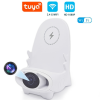Useful
Analysis of Monitoring System Networking Solutions: How to Choose Between Integrated NVR and Standalone Switch?
In the construction of intelligent security systems, the design of the network architecture directly affects the stability and scalability of the system. Faced with the two mainstream solutions of NVRs with integrated switching functions and independent switches, engineers and users often find themselves in a dilemma when making a choice. This article will conduct a deep analysis from the dimensions of technical principles, application scenarios, and cost-effectiveness, providing scientific networking suggestions for monitoring projects of different scales.
I. Comparative Analysis of Technical Architectures
The integrated NVR solution adopts an All-in-One design, embedding 5-8 100M/1000M electrical ports in a standard network video recorder to enable direct connection of front-end cameras. Its switching chip typically uses a streamlined architecture, with data throughput concentrated in the 30-60Mbps range, and supports basic VLAN division and QoS policies.
The standalone switch solution adopts professional-grade network equipment, with the switch backplane bandwidth reaching over 48Gbps. It supports advanced functions such as port aggregation, loop detection, and storm suppression. A typical 48-port Gigabit switch can provide a forwarding delay of less than 600ns, and when combined with Layer 3 management functions, it can achieve intelligent traffic scheduling.
From the perspective of hardware performance indicators, the packet forwarding rate of professional switches (such as 148.8Mpps) is more than ten times that of integrated solutions. When dealing with 4K ultra-high-definition video streams, the independent switch solution can ensure a packet loss rate of less than 1%, while the integrated device may have a packet loss rate exceeding 5% when handling 16 concurrent 4Mbps streams.
II. Application Scenario Adaptation Guide
For small and medium-sized scenarios (8 channels or less), such as convenience stores and micro shops, it is recommended to use integrated NVRs. Take Hikvision DS-7808N-K2 as an example. It has 8 built-in PoE ports that can be directly connected to cameras, eliminating the need for additional power supply equipment and reducing the overall cost by approximately 40%. Practical tests show that when 6 5-megapixel cameras (4Mbps per channel) are networked, the CPU occupancy rate of the device remains stable at below 35%.
For medium and large-scale projects (16 channels or more): Independent switch solutions must be adopted in scenarios such as parks and factories. It is recommended to configure a 24-port full Gigabit managed switch and divide a dedicated VLAN for monitoring. In a certain smart park project, Huawei S5720-28P-LI switches were used, and the port speed limit function was employed to control each video stream at 6Mbps, successfully achieving smooth transmission of 256 cameras without any lag.
The hybrid networking mode demonstrates unique advantages in special scenarios: Chain stores can adopt the architecture of a core switch at the headquarters and integrated NVRs at branch offices. A certain retail enterprise deployed TP-LINK TL-SG3428 as the core switch, and each branch store used Dahua NVR5216-16P. Centralized management was achieved through SD-WAN dedicated lines, saving 30% of network equipment investment.
III. Full Life Cycle Cost Accounting

In terms of initial procurement costs, the 8-channel integrated solution is approximately 2,000 yuan, while the independent solution (switch + NVR) requires 3,500 yuan. However, considering a 5-year operation and maintenance cycle, the failure rate of integrated equipment is as high as 12%, while the MTBF of professional switches can reach 100,000 hours. A calculation for a certain office building project shows that the 5-year TCO of using HIKVISION DS-3E0505P-E switch is 18% lower than that of the integrated solution.
The cost difference for expansion and upgrade is significant: when the ports of integrated equipment are fully loaded, the entire device needs to be replaced, while the independent solution can achieve smooth capacity expansion by stacking switches. When a school’s surveillance system was expanded from 32 channels to 96 channels, the Cisco CBS350 stacking solution was adopted, saving 65% of the upgrade cost compared to replacing the integrated NVR.
In terms of maintenance and management costs, the independent switch supports the SNMP network management protocol, enabling automatic topology discovery and fault location. The management platform that comes with the Ruijie RG-S2920G-24GT switch has increased the operation and maintenance efficiency of a certain logistics center by 40%, reducing the average fault recovery time from 45 minutes to 12 minutes.
In today’s era of accelerated digital transformation, the selection of monitoring system networking solutions should break away from the mindset of comparing individual devices. For lightweight scenarios with fewer than 8 nodes, integrated solutions can be preferred for rapid deployment. However, for professional scenarios with more than 16 nodes, it is necessary to build a switching network infrastructure. Forward-looking design is recommended to adopt a modular architecture, with 10-gigabit switches used in the core layer and PoE switches configured in the access layer, reserving upgrade space for AI video analysis and IoT integration. For medium-sized projects, a hybrid architecture is recommended: independent switches are used in key areas, and integrated NVRs are deployed at edge nodes, achieving the best balance between cost and performance.








